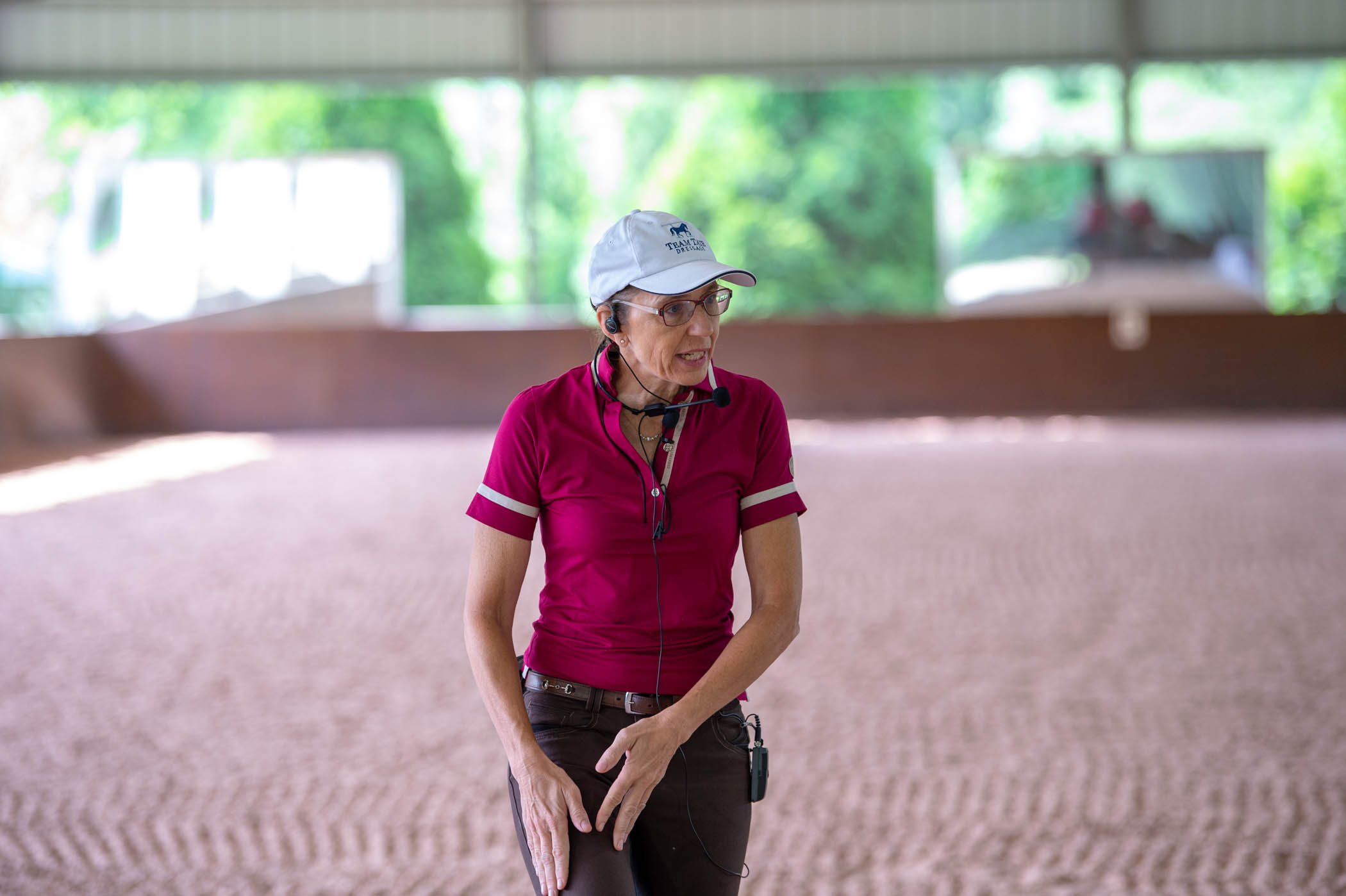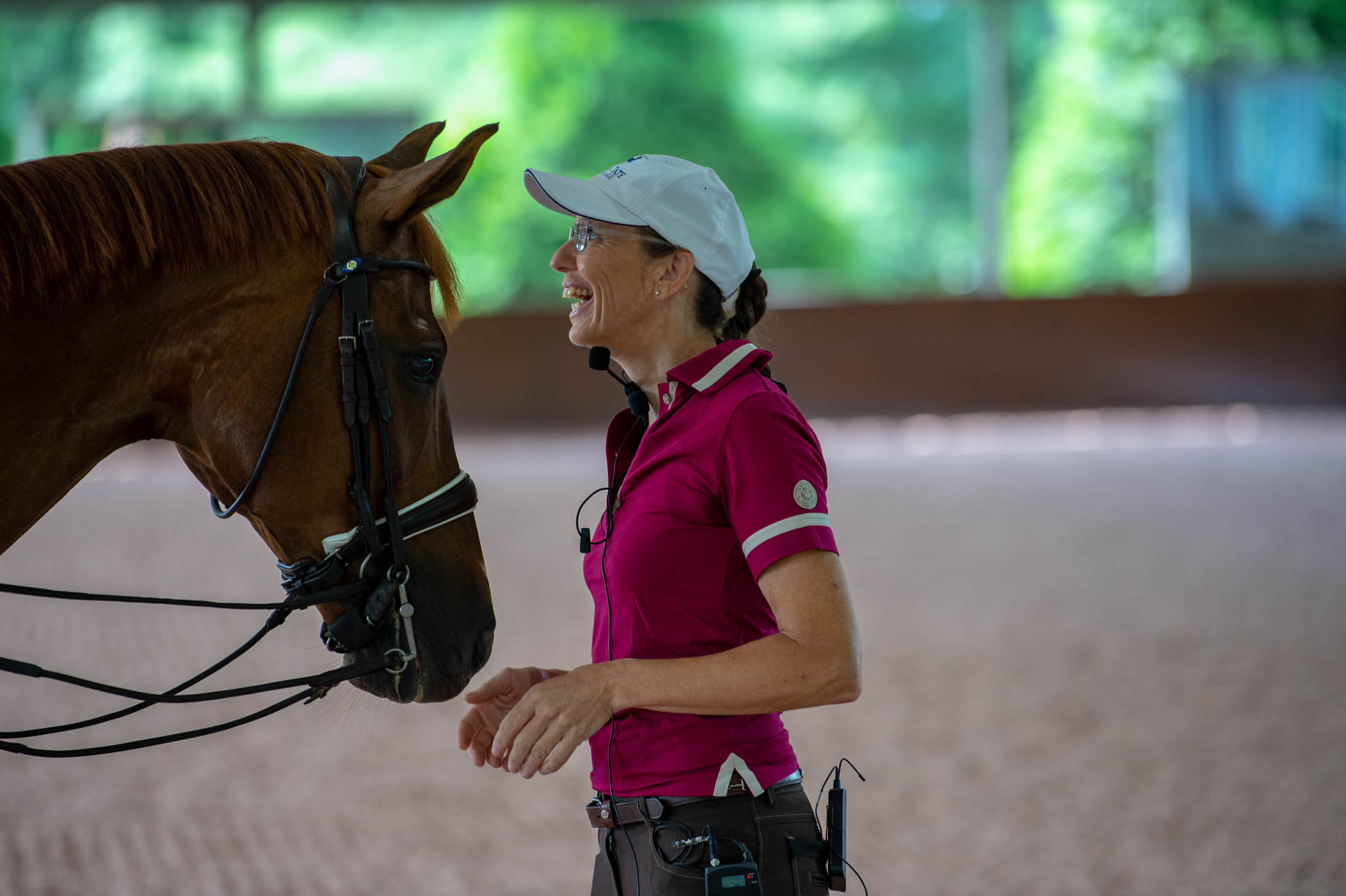What is balance in movement and how does the rider’s seat communicate with the horse? Just having a nice posture is not everything. You need to quietly follow the horse’s movement without disrupting him. If you push too much with your seat or work too hard with your pelvis or legs, the horse will want to shut down. Instead, you need to work on your internal connection, the invisible aids that are much clearer for the horse to understand.

So, how do we learn these deep invisible movements? When we look at how movement is learned by horses and riders, we know that rhythm, the basic building block in the Training Scale, plays a very big role. Without rhythm—the regularity of gaits—we can’t be in balance with our horse, and a rider who is not balanced and in rhythm will disturb the horse to no end. But when we are connected into the rhythm, we can give the correct aids.
Becoming part of the rhythm is very important and is even more important than keeping the right posture that we are taught in the early years. We must enable the horse to work. When I was a child, my parents taught me not to disturb the horse’s movement, and with that I rode up to Third Level. When the collection increases, then you need to help the horse. But until then, you should not try to interfere with the horse’s natural movement—become part of it and then you will have a partner who will be much more willing to work with you. (See “The Rider’s Role in Collection” below.)
To enhance the horse’s movement in collection, the rider needs to become more precise in the timing of the aids. It can be compared to a basketball player dribbling (bouncing) the ball. First the ball needs some push to start bouncing, but then the player controls the ball with a slight touch of the fingertips with perfect timing and feel. Similarly, the rider can use her weight aids to encourage the horse to “bounce” more off the ground and develop more cadence.
The second image that can explain this is that the horse’s movements should be supple and the horse should move with a “swinging” back. When you sit on a swing at a playground for the first time, you need someone to push the swing first so you feel how the swing can move. Later you learn to move the swing by using balance and timing so that with very little effort more and higher swinging movements can be achieved. Similarly in riding, a beginner first needs to learn to follow and feel the horse’s movement, then she can become part of this movement and only then can she become the one that the horse will follow. Good timing of the aids is the perfect interplay of balance and rhythm.
Understanding Balance
To first understand how delicate balance is, stand with equal weight on both legs and keep your eyes closed for a moment. Notice you are not standing still but swaying over your feet a bit. There are a lot of small, automatic movements that cannot be seen by an outsider. In fact, if someone was looking at you, they would think that you’re standing still. Next, roll your weight to the front of your feet. Notice how your toes dig into the ground? Now, shift your weight onto your heels and you will feel that your toes come up and your hands might come up, too. This is an automatic reaction in the body to help you balance—it’s called a balance reaction. When a horse starts cantering or trotting, many times a rider’s knees or hands come up in a balance reaction. An instructor can tell the rider to put her knees or hands down, but these reflexes are often stronger than the mind. This is why we need to get the balance of our own body correct before we can influence the horse.

Unmounted Exercises
The following exercises will help you strengthen your core and find balance, which translates to the saddle. Each exercise requires minimal movement, but the results are tremendous.
1. Wake Up Your Hips, Core and Spine. Before you stretch you need to be properly warmed up. Standing with your feet together and your legs straight, take 10-12 tiny, penguin-like steps forward and back, then 10-12 tiny steps right and left, then in a circle to the left and to the right. End by standing in place and doing quick, little steps while shaking your body all over and then, finally, relax.
Can you feel that your heart rate went up and that you’re beginning to warm up? These quick, little steps/shakes allow a compression and release into the joints. A short compression into a joint is called “approximation.” The exercise described above shakes and wakes up the hips and all the body structures, and the approximation into the joints (while in the upright position) is preparing the body to be upright against gravity. The elastic structures of the body respond and expand after being compressed, and the reflex system starts telling the deep (core) muscles to wake up and work to expand the joints again. Being alert gives the body a slightly higher muscle tone and with it a quicker reaction time to all balance reflexes. This is why it is a valuable warm-up task for riders. It prepares the whole system and especially the spine, for example, to be more elastic in the sitting trot.
2. The Hip Figure-Eight
. To gently mobilize your hips over the hip joints, I use a figure-eight movement. Stand with your legs hip-width apart, your knees forward and place your hands just below your hips. Next, shift your weight over your feet—from the heel of your left foot to the front of your left foot, then to the heel of your right foot to the front of your right foot, then again to the heel of your left foot, and so on. This shift of weight causes the pelvis to perform a figure-eight. The knees stay pointing forward and move as little as possible. This mobilizes the hip joints by moving the pelvis over a stable leg position. This is equivalent to the situation on horseback—especially in walk. The footfall of the horse in walk is left hind, left front, right hind, right front. So the figure-eight task prepares the pelvis to follow the horse’s movement and mobilizes (supples) the hip joints.
3. Core Stabilizers
. Keeping a long and stable core during half-halts and transitions is key for applying correct weight aids. Feeling how the abdominal muscles can engage in a supporting and elastic way can help you understand how to use positive tension from the center of your seat.
Some people think the only way to tighten your core muscles is to do sit ups. But there is another way. Take your finger as if you’re going to poke it into the middle of your belly. Instead of allowing your fingers to sink in, make your tummy hard and push your fingers out. It’s a small movement and easy to do if you hold your breath. But you want to do this while you’re breathing out, which is more challenging. To activate all the different muscles in your stomach, do this exercise in different areas of the stomach, for instance, above the belly button, below your belt and along your obliques.
Each of these exercises helps you understand balance and what is happening in your body. We have very little time on our horse and it always goes by so fast. Working on your core and balance allows you to have a better connection with your seat and, ultimately, your horse.
Find More on DTO!
Want more from Susanne von Dietze? In her video series “The Rider’s Seat,” Susanne takes us through additional unmounted and mounted exercises that help us understand and improve our balance in the saddle. Watch her mounted demo that offers great insight to how she teaches as well as an unmounted lecture that gives you a look at the theory behind her teachings. Enjoy these free videos at ondemand.dressagetoday.com and watch the entire series, plus more than 3,000 others, by taking advantage of a free trial membership with DT OnDemand at ondemand.dressagetoday.com.
Susanne von Dietze is a leader in equestrian biomechanics. A physiotherapist, licensed Trainer A instructor and judge for dressage and show jumping, she gives lectures and seminars throughout the world, including at the prestigious German Riding Academy in Warendorf. She is a native of Germany and now lives with her husband and three children in Israel, where she competes at the international level. She is the author of two books on the biomechanics of riding, “Balance in Movement” and “Rider and Horse, Back to Back.” She is also the author of Practical Horseman’s “Clinic” column.











